Successfully converting prospects into customers is an art form. An art that requires experience, expertise, and, most of all, patience. And even though selling your solutions may seem simple enough from the outside, it’s never a straightforward process.
How people decide what products/services to spend their hard-earned money on relies on a rather intricate decision-making process called the sales funnel. And this funnel (or cycle or journey) is becoming more complex by the year.
According to recent survey data, over 30% of B2B organizations take between one and three months to close a deal (with longer wait times for higher-value interactions). Plus, it’s not just when targeting fellow businesses that brands need to take action to speed up the sales process. Data from Power Reviews shows that many people are researching purchases more than before due to a changing economic climate.
With this in mind, your brand must employ tactics to move leads through the sales funnel. And the best way to do it? Invest in content marketing. Content can grab your audience’s attention as well as play a significant role in the sales cycle.
On the one hand, you can use content to nurture readers interested in your solutions but need more data before committing to a purchase decision. Or, you can employ content to nudge prospects toward a conversion, especially when they’re already confident in your products’ effectiveness and need a final push.
This article will guide you through some of the best content marketing strategies you can use as tools to move your leads through your brand’s sales funnel, either by nurturing a connection or encouraging leads to convert. Let’s get into it.
Position Your Product as a Viable Alternative to Existing Solutions
One of the best ways to employ content to move leads through the sales funnel is to publish articles that compare your solutions to those offered by competitors.
On the surface, comparing your products to alternatives may seem counterintuitive. But, consumer behavior data shows that most people seek out this type of content in the first place. According to Statista, 82% of U.S. consumers ‘often’ compare prices before buying online.
If you know that your target audience seeks out product comparison content, why not give them what they want? It can be a great way to create a market for your solution and nurture prospects into customers, considering that you can do it on your site, where you can control the narrative.
When investing in comparison content, you want to create an environment that benefits your brand. The best way to achieve this is to compare your solutions with their alternatives in a particular context. Ideally, you’ll do this by educating your readers on how to solve a distinctive pain point.
For a great example of how a brand uses this format to nurture leads into customers, check out the Best Productivity Apps for Mac article on the Clockify website.
This resource compares ten different software solutions. But, instead of trying to contend with direct competitors, Clockify chooses one product alternative for each possible consumer pain point. That way, the brand positions its solution as superior in its niche (time tracking) while giving readers an objective overview of alternative products they can use to maximize work productivity.

Tell Detailed Customer Success Stories with Case Studies
Adding social proof to your landing pages is a foolproof way to boost conversions.
Perhaps this type of content won’t instantly inspire web visitors to convert. But it does a marvelous job of establishing brand credibility, supporting your claims, and showing your prospects that you have a positive track record of removing customer pain points.
So, if you’re looking for content marketing strategies that will allow you to nurture more web visitors into return customers of your brand, why not produce and publish case studies on your blog?
One of the main reasons this format works so great for building trust (which is crucial for 81% of consumers making purchase decisions) is that it combines branded content with UGC.
Detailed case studies are effectively long-form adverts highlighting everything your business does well. They allow you to present prospects with real-world data. They help mold your prospects’ expectations regarding what they can get from your brand. Finally, they support your value propositions with proof from happy customers, allowing you to nudge on-the-fence consumers toward the lower stages of the sales funnel.
To see a great example of how you can use this format to encourage consumer trust and move leads through your brand’s sales funnel, check out the Bailey Nelson case study on the Vidico website.
The article advertises the impressive results Vidico acquired for the customer. The case study goes over the main challenges the brand had to overcome. Plus, it outlines some of the strategies used to remove those setbacks.
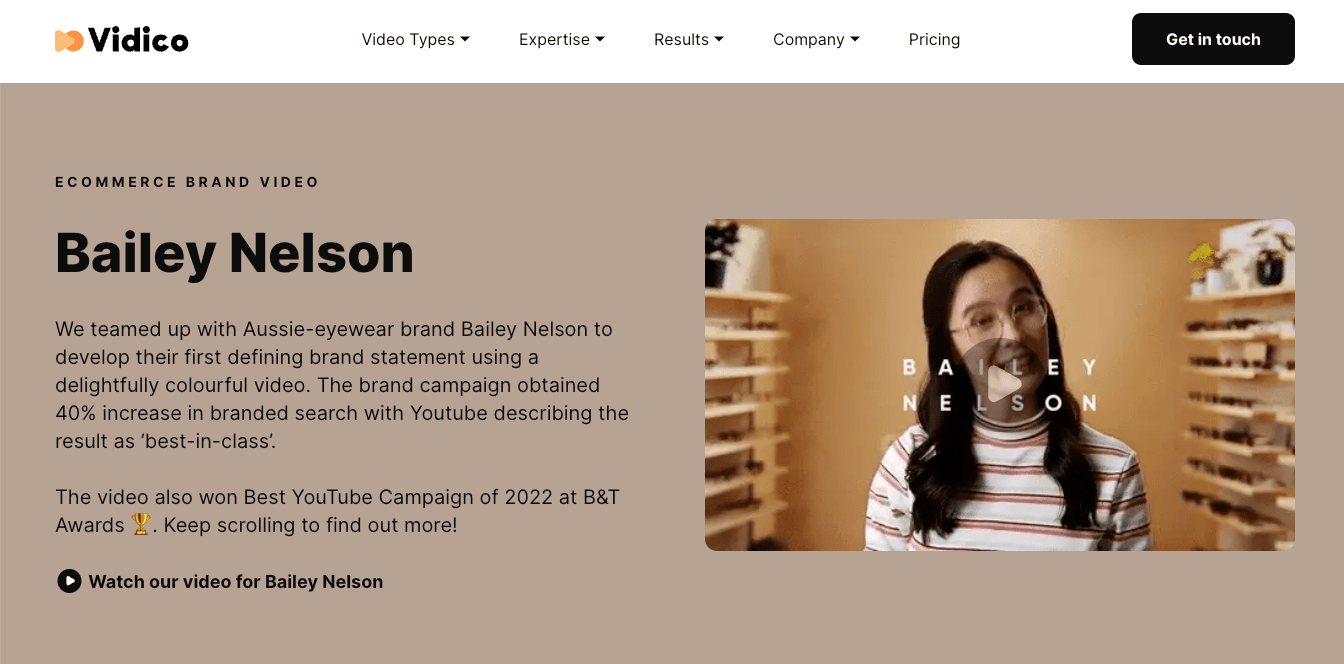
Additionally, the resource also includes an example of a video Vidico created for Bailey Nelson, allowing all potential customers a first-hand look at what they could receive by investing in Vidico’s video marketing services.
Collaborate with Industry Experts to Enhance Brand Authority
Over the past couple of years, expert testimonials have become increasingly impactful in allowing businesses to win customers’ trust.
Data from 2022 demonstrates that young consumers consider experts and scientists to be some of the most credible brand spokespeople/ambassadors. Plus, the latest Edelman Trust Barometer shows that 74% of people think scientists are as trustworthy as their peers.
If you’re exploring ways to nurture web visitors into customers through leveraging trust, consider bringing on some industry expert voices to enhance your brand’s authority.
The best thing about content marketing strategy is that you can adapt it to fit your brand’s needs to show how well-established industry experts are happy to be associated with your organization.
For instance, if you want to use on-page content to maximize brand trust and highlight your products’ value, conduct interviews with scientists or experts to support your brand’s claims.
Superhuman regularly does this on its blog. In the example below, the brand invited Armand Farrokh from 30MPC to share his top 6 Ways to be an Inbox Superhuman and show readers the outcomes they can achieve with the brand’s software.
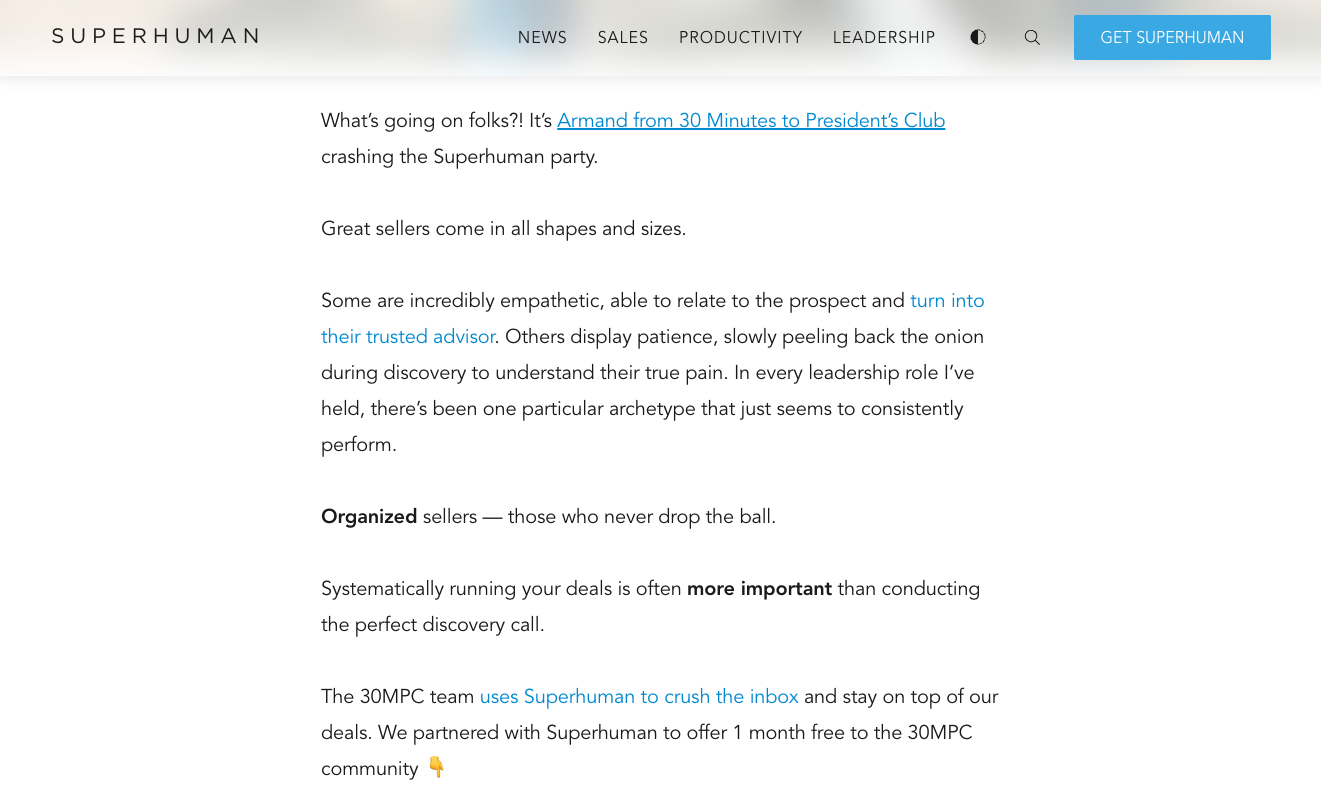
Or, if you’re looking to employ content marketing to boost brand/product awareness while simultaneously establishing trust as a basis for nurturing leads into customers, explore opportunities for guest posts or interviews on expert-led off-site platforms.
For example, check out how Mercury does it. Knowing that it wants to capture and convert leads from the business and finance sector, this brand’s team regularly appears on relevant industry podcasts, like the Science of Scaling show hosted by Hubspot’s founding CRO.

Announce and Discuss New Product Features with Confidence
Post-purchase support is a crucial factor for buyers evaluating products. In fact, if you look at Gartner’s latest State of Software Investment report, you’ll find that the top three factors for selecting viable solutions include cost, security, and features/functionality.
So, to win over customers in the mid stages of the sales funnel and nurture them from prospects to loyal customers, use content to prove your brand’s commitment to continually meeting your target audience’s expectations.
Something as simple as regularly announcing and discussing new product features can show how active your brand is in the product development sector, boosting your business’ credibility and ensuring potential clients perceive your organization as a customer-first business.
For a great example of how to do this, check out the Logz.io Blog section. Here, you’ll see several pieces of content dedicated to announcing new product features and updates, most notably those that employ AI to improve user experience.
What stands out about this brand’s approach to new feature announcements is that it regularly explains why it decided to develop new software capabilities and provides customers with examples of how they can incorporate new features in their workflows.

Show Readers How Complex Life Is without Your Product
Sometimes, the best way to move leads toward the bottom stages of the sales funnel isn’t to push them to convert. Instead, it’s to paint a picture of what life would look like without your product, encouraging them to want to buy off their own volition.
By investing in content that demonstrates the complexity of the processes your product solves, you can frame your solutions as effective and (perhaps even) irreplaceable.
For example, check out how Going does this in its How to Use Google Flights guide. The article instructs readers on the multi-step process of using Google Flights to find cheap airfare. Thanks to a high-quality resource, the business effectively earns its target audience’s trust and positions itself as a credible source.
But how does this article benefit Going? The brand regularly addresses the drawbacks of Google’s solutions throughout the article. Each time, it presents readers with the simpler alternative — Going’s free membership — which is more convenient. Going also ensures it’s positioned as the more user-friendly way of booking airline tickets than going through the complex process required to book through Google.

Help Existing Customers Get the Most Out of Their Purchases
Value for money tops almost every single buyer’s list of requirements when searching for viable solutions to their pain points. The Q1 2024 Consumer Trends Report from Jungle Scout found that 71% of people prioritize products with the lowest prices when shopping.
On the one hand, this data may show that you need to develop intelligent pricing strategies to appeal to your target audience. However, it also proves that helping buyers extract value from their purchases is essential for delivering a superior customer experience.
One excellent way to do the latter is to invest in content that helps existing customers extract more from their purchases.
This is an exceptional method to nurture interested leads into customers. It’s also a great strategy for encouraging repeat conversions by maximizing buyer satisfaction and creating customer loyalty.
Check out the JetBrains website for an excellent example of content that does this. With an entire section dedicated to helping YouTrack users get more out of the software, the brand presents customers (and prospects) with dozens of in-depth educational resources showing them how to employ the software for diverse use cases.
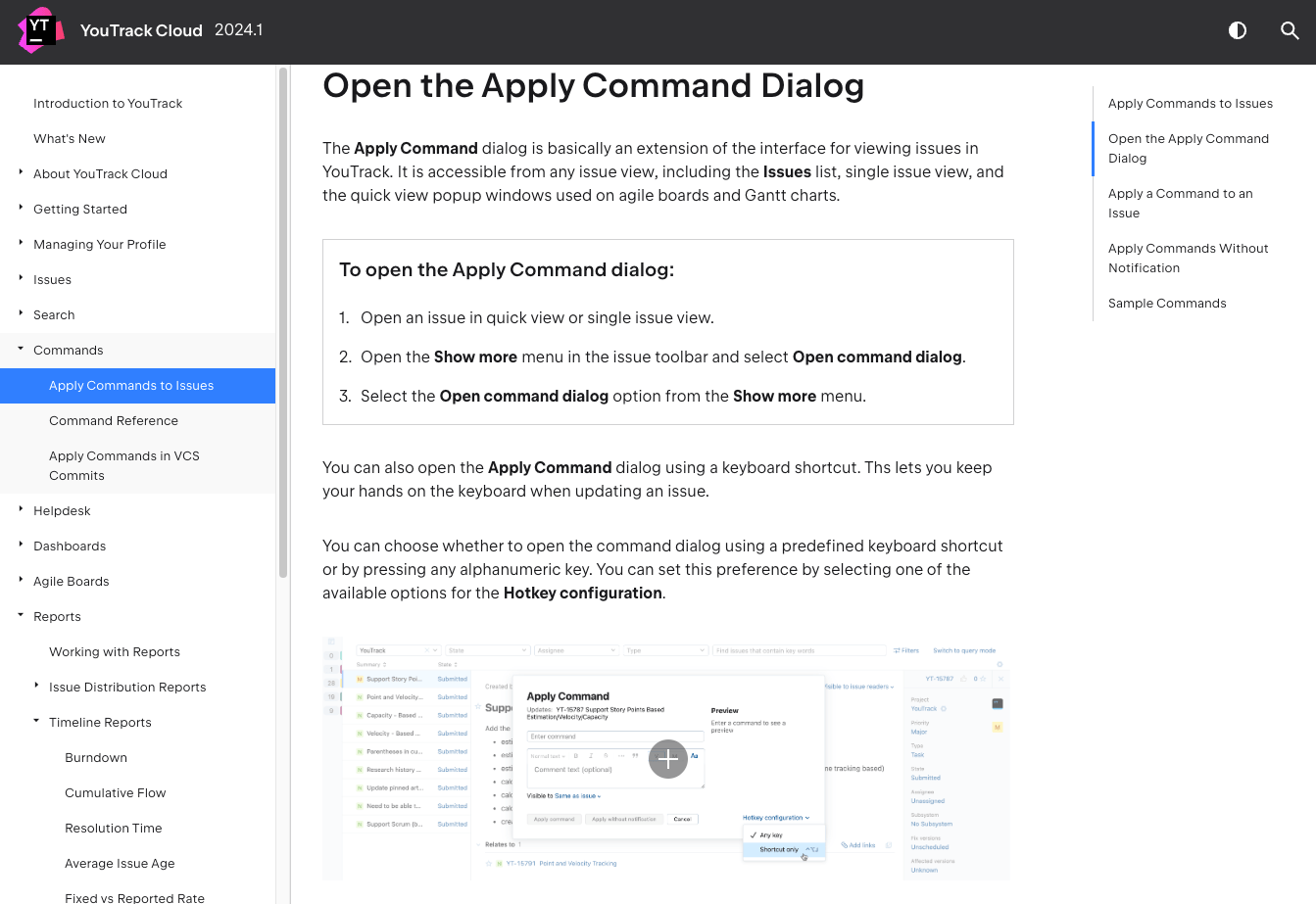
Ensure Your Sales Funnel Gateway Is Enticing
As you explore ways to use content marketing to move leads through your brand’s sales funnel, remember that your brand’s value propositions are some of the most impactful pieces of content meant to convert customers.
But, while you can achieve spectacular results by addressing your audience’s pain points, reminding them of their frustrations, and painting an appealing picture of a worry-free life due to using your solution, you need your prospects to want to convert.
One content marketing strategy that can help you ensure this result is to make your sales funnel gateway more enticing for your target audience.
In addition to strategically placing your value props, make them demonstrate the full breadth of benefits your prospects receive by converting. Furthermore, do your best to minimize the commitment required from leads to gain access to those benefits.
For a great example of a brand doing this, check out the BJJFanatics guide to Jiu Jitsu. It’s a standard informational piece of content meant to raise people’s awareness regarding martial arts. However, it includes a splendid UI element that presents readers with the brand’s subscription product.
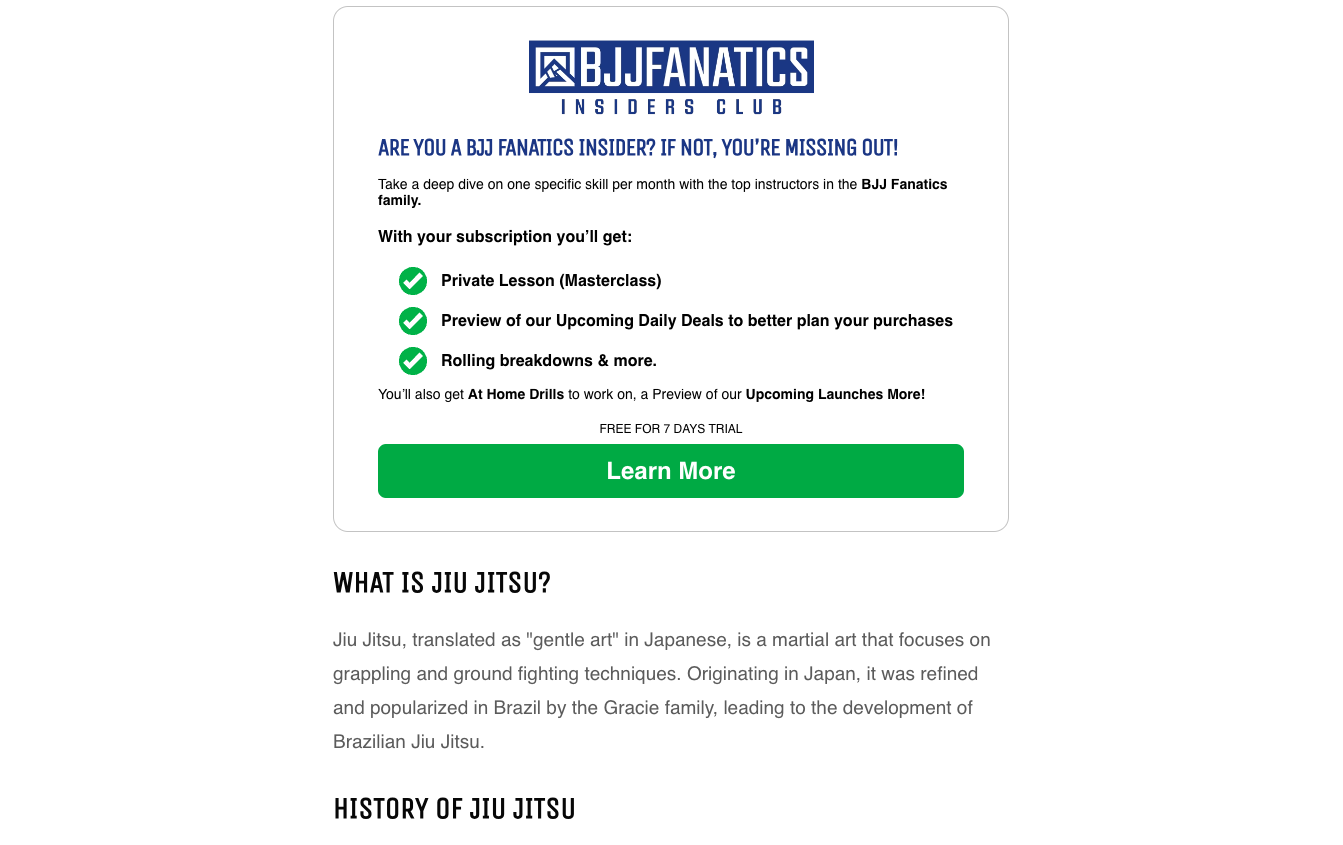
Check out how effectively this conversion element communicates the value Bjjfanatics offers.
It highlights benefits like private lessons and deals. The section mentions the at-home workout plans subscribers receive. Lastly, it points out that it’s available with a 7-day free trial — more than enough for prospects to evaluate whether the Insiders Club delivers the value they’re searching for.
Embed Conversion Mechanisms in Blog Posts
One of the mistakes marketers make when investing in content is thinking it only acts in the top stages of the sales funnel. Still, despite the effectiveness of blogging in reaching awareness-stage consumers, it can play a significant role further down the sales funnel.
If you think about the role of content in converting read-to-buy customers, it can be an unparalleled method of winning over loyal customers. Why?
The first reason is that many consumers make purchase decisions on impulse.
Research suggests that between 40% and 80% of all shopping decisions are made on impulse, proving how important it is to present customers with the right conversion-inspiring content at the right moment in their buyer’s journey.
Secondly, the role of content — at least in the context discussed in this article — is to move prospects through the sales funnel. But, to effectively do so, each of your blog posts must contain a conversion mechanism that aligns with your target audience’s needs and preferences.
With this in mind, the best way to maximize conversions among content readers is to embed conversion elements directly in your articles.
This will prevent you from waiting for prospects to navigate to product pages to make purchases. Plus, it will allow you to encourage impulse purchases with a few well-placed UI elements.
For inspiration on how to do this, check out the 8-Week Guide to Body Recomposition from Transparent Labs.
Under the Supplements for Body Recomposition heading, the brand presents readers with clickable product recommendations, allowing them to purchase straight from the blog post without forcing them to navigate to the relevant product page of the site (and potentially wasting their time).
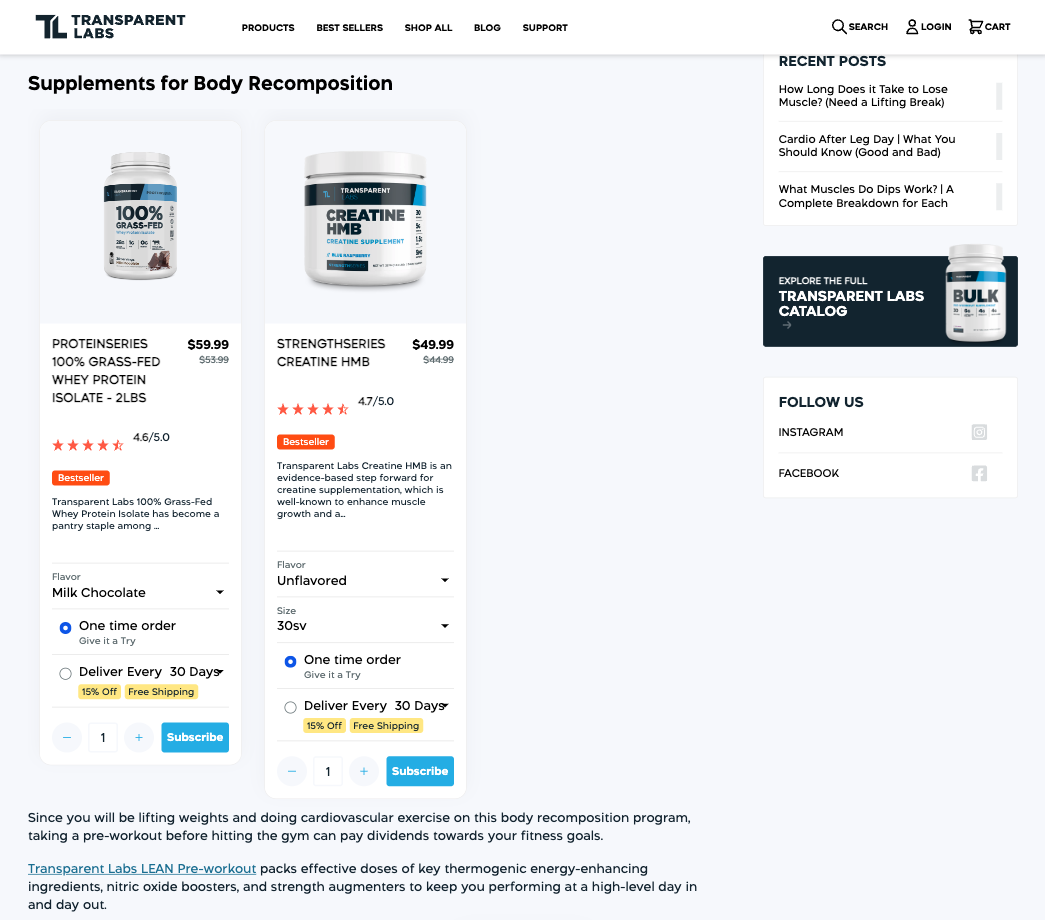
Strategically Drive Traffic to High-Converting Blog Posts
Finally, as you explore tactics to nudge bottom-of-the-funnel leads toward a purchase, remember to intelligently integrate your content marketing efforts with your email marketing strategies.
For your content to effectively convert customers, it needs to find its intended audience. And the only way to do that is to dedicate as much time to distribution as you do to production.
In addition to publishing on your site’s Blog section and repurposing articles into social media posts, it’s also essential to employ email marketing. It’s one of the most cost-effective ways to stay in touch with your target audience and nurture leads into customers (and customers into return buyers).
However, the one commonly overlooked benefit of strategic content distribution is that it allows you to drive traffic to high-converting blog posts on your site. So, instead of driving traffic to your brand’s homepage, use the Get a Newsletter email marketing feature to send prospects to select blog posts to maximize their chances of converting into buyers.
For example, the content team at Writer regularly uses the brand’s newsletter to drive web traffic to articles with a high conversion potential. But, in addition to using customer research to identify relevant topics, the Writer content team also explores ways to turn each article into a conversion-boosting resource that inspires readers to sign up for the service by addressing the pain points that made them click the newsletter link in the first place.
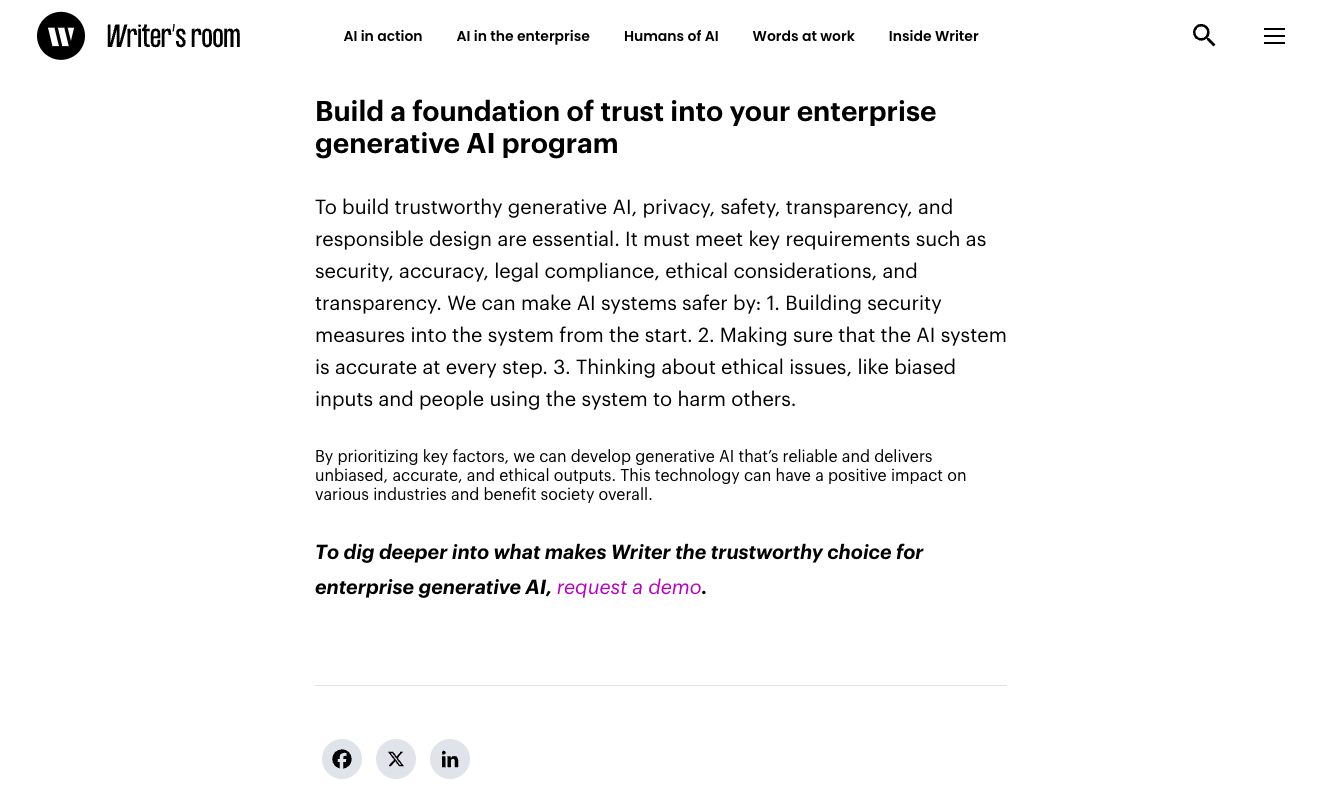
Wrapping Up
Employing content marketing can be about so much more than just attracting your brand’s target audience.
When approached correctly, great content can engage your prospects. But it can also move them through the sales funnel, helping you nurture dedicated fans of your brand, convert more customers, and encourage repeat purchases.
The tactics covered in this article are all excellent strategies to implement in your content marketing efforts. Don’t try to add them all to your arsenal at once. Instead, identify the ones that align with your goals the best. Then, measure their effectiveness and look for ways to make them your own.
Get started with email marketing
Create beautiful email newsletters for free with Get a Newsletter and reach your subscribers and customers in a heartbeat.
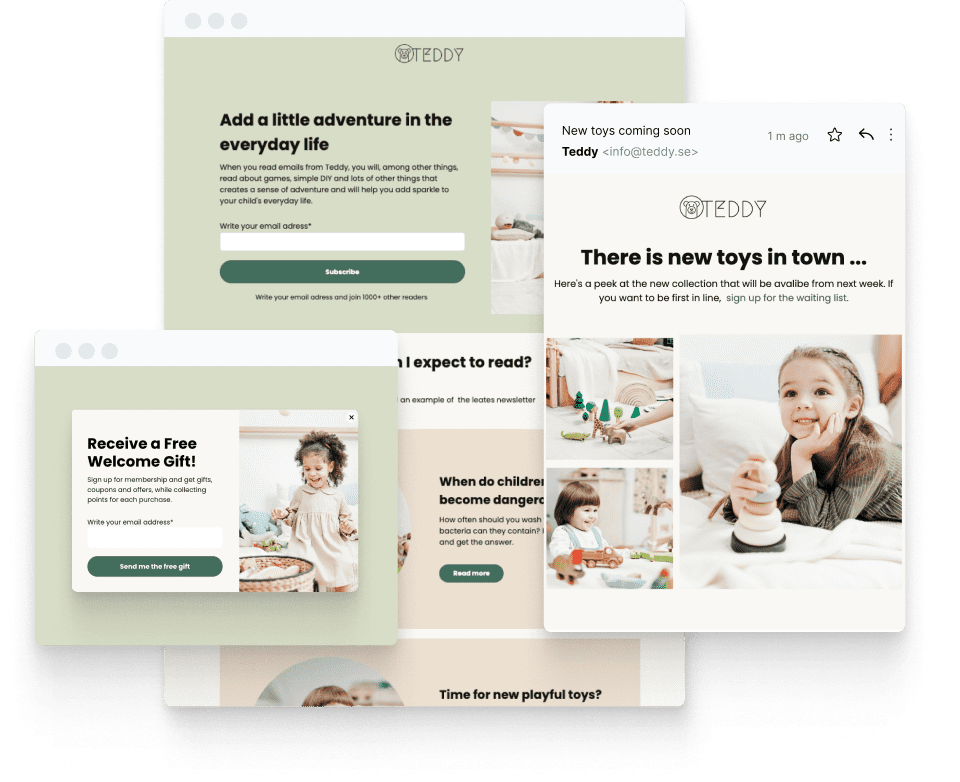

Leave a Reply